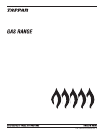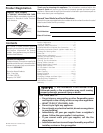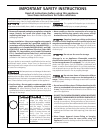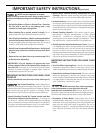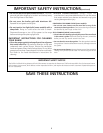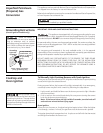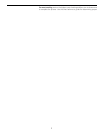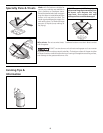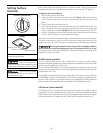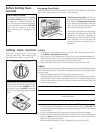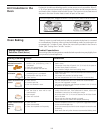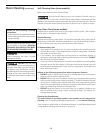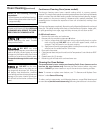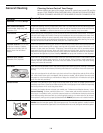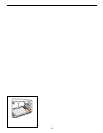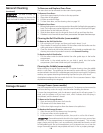
4
IMPORTANT SAFETY INSTRUCTIONS(continued)
NEVER use this appliance as a space
heater to heat or warm the room. Doing so may result in
carbon monoxide poisoning and overheating of the
oven.
• Do Not Use Water or Flour on Grease Fires—Smother
the fire with a pan lid, or use baking soda, a dry
chemical or foam-type extinguisher.
• When heating fat or grease, watch it closely. Fat or
grease may catch fire if allowed to become too hot.
• Use Only Dry Potholders—Moist or damp potholders
on hot surfaces may result in burns from steam. Do not
let the potholders touch the flame or burners. Do not use a
towel or other bulky cloth instead of a potholder.
• Do Not Heat Unopened Food Containers—Build-up of
pressure may cause the container to burst and result
in injury.
• Remove the oven door from any unused range if it is
to be stored or discarded.
• IMPORTANT—Do not attempt to operate the oven
during a power failure. If the power fails, always turn
the oven off. If the oven is not turned off and the power
resumes, the oven will begin to operate again. Food left
unattended could catch fire or spoil.
IMPORTANT INSTRUCTIONS FOR USING YOUR
COOKTOP
• Know which knob controls each surface heating unit.
Use Proper Flame Size—Adjust flame size so
it does not extend beyond the edge of the utensil. The use of
undersized utensils will expose a portion of the burner flame to
direct contact and may result in ignition of clothing. Proper
relationship of utensil to flame will also improve efficiency.
• Utensil Handles Should Be Turned Inward and Not
Extend Over Adjacent Surface Burners—To reduce the
risk of burns, ignition of flammable materials, and spillage
due to unintentional contact with the utensil, the handle of
the utensil should be positioned so that it is turned inward,
and does not extend over adjacent surface burners.
• Never Leave Surface Burners Unattended at High
Settings—Boilovers cause smoking and greasy spillovers
that may ignite, or a pan that has boiled dry may melt.
• Protective Liners—Do not use aluminum foil to line surface
burner pans, oven bottom or any other part of the range. Use
of protective liners or aluminum foil may interfere with heat
and air distribution, and combustion. Damage to the range or
personal injury may result.
• Glazed Cooking Utensils—Only certain types of glass,
glass/ceramic, ceramic, earthenware, or other glazed
utensils are suitable for rangetop service without
breaking due to the sudden change in temperature. Check
the manufacturer's recommendations for rangetop use.
• Do Not Use Decorative Surface Burner Covers. If a burner
is accidentally turned on, the decorative cover will become
hot and possibly melt. You will not be able to see that the
burner is on. Burns will occur if the hot covers are touched.
Damage may also be done to the cooktop or burners because
the covers may cause overheating. Air will be blocked from
the burner and cause combustion problems.
IMPORTANT INSTRUCTIONS FOR USING YOUR
OVEN
• Use Care When Opening Door—Stand to the side of the
range when opening the door of a hot oven. Let hot air or
steam escape before you remove or replace food in the oven.
• Keep Oven Vent Ducts Unobstructed. The oven is vented
below the backguard. Touching the surfaces in this area
when the oven is operating may cause severe burns. Also, do
not place plastic or heat-sensitive items on or near the oven
vent. These items could melt or ignite.
NEVER cover any slots, holes or passages
in the oven bottom or cover an entire rack with
materials such as aluminum foil. Doing so blocks air flow
through the oven and may cause carbon monoxide poisoning.
Aluminum foil linings may trap heat, causing a fire hazard.
• Placement of Oven Racks. Always place oven racks in
desired location while oven is cool. If rack must be moved
while oven is hot, use extreme caution. Use potholders and
grasp the rack with both hands to reposition. Do not let
potholders contact the oven burner flame or interior of the
oven. Remove all utensils from the rack before removing
rack.



